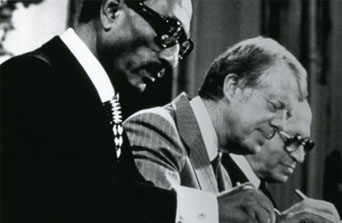The Corps Helped Implement a Peace Settlement between Israel and Egypt with the Construction of Israeli Airbases in the Negev Desert
One of the roles of the Corps of Engineers—that of supporting American policy overseas through management of construction projects—is not widely known outside the Corps. One of the Corps’ major projects that was undoubtedly a crucial and pivotal success in this regard was the design and construction of two modern Israeli airbases from 1978 to 1982.
The project arose following the signing of the “Framework for the Conclusion of a Peace Treaty Between Egypt and Israel” at Camp David in September 1978. Israel was reluctant to withdraw from the Sinai Peninsula and abandon its airbases there. U.S. Secretary of Defense Harold Brown suggested relocating the airbases and offered U.S. assistance in rebuilding them—a gesture that factored largely in the Israeli decision to return the Sinai to Egypt. The Israelis relied heavily on their air force, and it was crucial to them to have operational replacement bases before leaving the Sinai. Successful relocation depended upon the U.S. commitment of aid.
 |
 |
Egyptian President Anwar Sadat,
U.S. President Jimmy Carter and
Israeli Prime Minister Menachem Begin
sign the Camp David Accord. |
The executive office and the construction division
were transferred to the Palace Hotel,
Tel Aviv, in Dec. 1979. |
Five days after the framework was signed, the Department of Defense alerted the Corps of Engineers and the U.S. Air Force to the possible mission. Corps personnel immediately began planning and preparation, and soon Chief of Engineers Lt. Gen. John Morris selected a team to lead the effort. Although still uncertain of the exact nature of the mission, the Corps located potential sites for the new airbases, estimated costs, and mulled over contracting possibilities, even though the U.S. had yet to commit to building the airbases, the parties had yet to sign the official peace treaty, and Congress had yet to appropriate any funds for the project.
The North Atlantic Division (NAD) devised a management plan by late 1978. NAD expeditiously created and staffed local offices to support the project, and they planned for a construction organization with a headquarters in Israel and an office at each airbase. NAD envisioned a staff of 180 to 200 individuals, with a majority being active duty military because they were easier to reassign after project completion.
This aggressive planning effort paid off. In March 1979 DOD formally assigned the mission. While the U.S. Air Force managed the overall airbase program, DOD designated the Corps of Engineers the design and construction agent to oversee the construction within the program.
The objective was to construct in the Negev Desert two modern airbases, at Ramon and Ovda, within three years.

Construction in rough desert conditions
The location of the work at obscure desert sites magnified the demands of a tight schedule. Nonetheless, the Corps of Engineers considered timely completion the first priority—the one alternative to finishing on time was to finish early. The Corps’ emphasis on the deadline dominated throughout the project. Design and procurement progressed smoothly through 1980, and by 1981 construction of the airbases was well underway.
 |
|
| Working on the airbase runway |
|
In May of 1982 a ceremony marked the inauguration of the Ramon and Ovda airbases, allowing for successful relocation of Israel’s air force and prolonged peace between Egypt and Israel. The Corps had not retreated from the difficulties posed by a $1 billion project that was rife with strict, crucial deadlines and risk-laden challenges. While success did not come suddenly or easily, Corps personnel attained it through their quick, eager response to the assignment. Overall, the Israeli airbase project was a major accomplishment and today remains one of the most prominent Middle East construction projects completed by the Corps.
For more information, see Frank N. Schubert, Building Air Bases in the Negev: The U.S. Army Corps of Engineers in Israel, 1979–1982 (Washington, D.C.: Office of History, U.S. Army Corps of Engineers and Center of Military History, U.S. Army, 1992).
* * *
July 2010